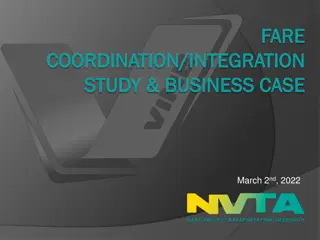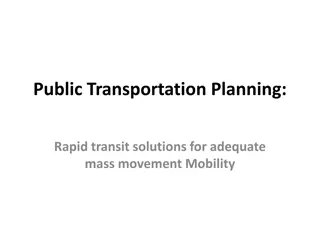Understanding Transit Modes: A Comparative Analysis by Watkins, LaMondia, and Brakewood
This study delves into defining transit modes, exploring different families of transit modes, and comparing mode selection in the US. The materials developed by K. Watkins, J. LaMondia, and C. Brakewood provide insights into transit mode characteristics like right-of-way systems, technology types, and organizational oversight. It also discusses the pros and cons of different rights-of-way classes, system technologies, and other key factors influencing transit mode decisions.
Download Presentation

Please find below an Image/Link to download the presentation.
The content on the website is provided AS IS for your information and personal use only. It may not be sold, licensed, or shared on other websites without obtaining consent from the author. Download presentation by click this link. If you encounter any issues during the download, it is possible that the publisher has removed the file from their server.
E N D
Presentation Transcript
Unit 1: Introduction Comparing Transit Modes Materials developed by K. Watkins, J. LaMondia and C. Brakewood
Outline Transit mode definition. Families of transit modes. Comparison of modes and mode selection in the US. Materials developed by K. Watkins, J. LaMondia and C. Brakewood
First, lets define the transit were working with TRANSIT MODE DEFINITION Materials developed by K. Watkins, J. LaMondia and C. Brakewood
Transit Mode Definition 4 Basic Characteristics: Right-of-Way (ROW) System Technology Types of Service Organizational Oversight Materials developed by K. Watkins, J. LaMondia and C. Brakewood
Characteristic 1: Right-of-way Street Transit Semi-rapid Transit Rapid Transit ROW C Mixed Traffic ROW B Physically Separated ROW A Fully controlled Speed of Vehicles Operating & Capital Costs Materials developed by K. Watkins, J. LaMondia and C. Brakewood
Examples of ROW Classes Class A: Boston Red Line Class B: Dublin Light Rail Class C: MARTA Bus Materials developed by K. Watkins, J. LaMondia and C. Brakewood
Pros and Cons of Rights of Way + + + + Highest performance Electric guided technology High safety Short dwell time ROW A - - - Highest investment cost Rigid alignment Grade-separated stations require land and longer access + Higher performance speed, reliability, capacity, comfort, safety Use of longer vehicles Stronger identity / image Lower per passenger operating cost Can be electrified ROW B + + + + - - - Require space for ROW Higher investment Special signals or control / priority measures ROW C Materials developed by K. Watkins, J. LaMondia and C. Brakewood
Characteristic 2: System Technology Support: Vertical contact Guidance: Lateral control Propulsion: Power system Control: Spacing Rubber tire on pavement Steel wheel on rail Vehicle on water, mag lev, etc. Steered by driver Guided by track Diesel engine Electric motor Hybrid Magnetic forces, etc Manual/visual Manual/signals Automatic Materials developed by K. Watkins, J. LaMondia and C. Brakewood
Characteristic 3: Types of Service Trip Served Short-haul City transit Regional transit Time of Day Regular Peak Special Stopping Schedule See next slide Materials developed by K. Watkins, J. LaMondia and C. Brakewood
Characteristic 3: Types of Service Express Rapid Local Materials developed by K. Watkins, J. LaMondia and C. Brakewood
Characteristic 4: Organization Oversight On-Demand Individuals On-Demand Group Image:IMGP1004.JPG Materials developed by K. Watkins, J. LaMondia and C. Brakewood
Characteristic 4: Organization Oversight Public Group Materials developed by K. Watkins, J. LaMondia and C. Brakewood
Characteristics of Organizational Oversight Characteristic Private On-Demand Public Designation Private Paratransit Transit Availability Owner Public Public Supplier User Carrier Carrier Route determination User (flexible) User User (carrier) Carrier (fixed) Time-schedule determination User (flexible) User User (carrier) Carrier (fixed) Cost-price User absorbs Fixed RATE Fixed FARE Carrier type Individual Group Individual Group Group Modes SOV Carpool Taxi Dial-a-ride Street transit Motorcycle Vanpool Rent Car Jitney Semirapid transit Bicycle Car Share Charter Rapid Transit Walking Bike Share Specialized Materials developed by K. Watkins, J. LaMondia and C. Brakewood
This classification of usage leads us to our FAMILIES OF TRANSIT MODES Materials developed by K. Watkins, J. LaMondia and C. Brakewood
4 Major Transit Families Street Transit Right-of-Way (ROW) System Technology Types of Service Rapid Transit Right-of-Way (ROW) System Technology Types of Service Semi-rapid Transit Right-of-Way (ROW) System Technology Types of Service Specialized Transit Right-of-Way (ROW) System Technology Types of Service Materials developed by K. Watkins, J. LaMondia and C. Brakewood
Regular Bus Articulated Bus in London (Bendy Bus) Materials developed by K. Watkins, J. LaMondia and C. Brakewood
Express Bus GRT Xpress Bus Materials developed by K. Watkins, J. LaMondia and C. Brakewood
Trolleybus Trolleybus in Zurich, Switzerland Materials developed by K. Watkins, J. LaMondia and C. Brakewood
Streetcars Double Decker Streetcars in Hong Kong Materials developed by K. Watkins, J. LaMondia and C. Brakewood
Semi-rapid Transit Modes Bus Rapid Transit Light Rail Transit Automated Guideway Transit Materials developed by K. Watkins, J. LaMondia and C. Brakewood
Bus Rapid Transit TransJakarta, Jakarta, Indonesia Materials developed by K. Watkins, J. LaMondia and C. Brakewood
Light Rail Transit Dallas Area Regional Transit Materials developed by K. Watkins, J. LaMondia and C. Brakewood
Automated Guideway Transit Hartsfield-Jackson Atlanta Airport Materials developed by K. Watkins, J. LaMondia and C. Brakewood
Rapid Transit Modes Rail Rapid Transit (Metro) Light Rail Rapid Transit Rubber-tired Rapid Transit Monorail Regional (Commuter) Rail Materials developed by K. Watkins, J. LaMondia and C. Brakewood
Rail Rapid Transit (Metro) Atlanta, Georgia Materials developed by K. Watkins, J. LaMondia and C. Brakewood
Light Rail Rapid Transit Docklands Light Railway (DLR) in London Materials developed by K. Watkins, J. LaMondia and C. Brakewood
Rubber-tired Metro Montreal, Canada Materials developed by K. Watkins, J. LaMondia and C. Brakewood
Monorail Kuala Lumpur, Malaysia Materials developed by K. Watkins, J. LaMondia and C. Brakewood
Commuter Rail Boston, Massachusetts Materials developed by K. Watkins, J. LaMondia and C. Brakewood
Specialized Modes Terrain-Specialized Cable cars Funicular / inclined plane Aerial tram Water-based Ferry Materials developed by K. Watkins, J. LaMondia and C. Brakewood
Cable Car San Francisco, CA Materials developed by K. Watkins, J. LaMondia and C. Brakewood
Funicular / Inclined Plane Pittsburgh, PA Materials developed by K. Watkins, J. LaMondia and C. Brakewood
Aerial Tram Image:Roosevelt Island Tramway.jpg Roosevelt Island, NY Materials developed by K. Watkins, J. LaMondia and C. Brakewood
Ferrys Seattle, Washington Seattle, WA Materials developed by K. Watkins, J. LaMondia and C. Brakewood
COMPARISON OF MODES & MODE SELECTION IN THE USA Materials developed by K. Watkins, J. LaMondia and C. Brakewood
2010 APTA Modal Facts # Systems 1,206 Passenger Trips 5,256 mil Passenger Miles 21,013 mil 10,874 mil 1,494 mil 16,407 mil 2,173 mil Bus Commuter Rail Paratransit Heavy Rail Light Rail Trolleybus Monorail Inclined Plane Publico Aerial Tramway Automated Guideway Transit Cable Car Ferryboat 28 464 mil 190 mil 3,550 mil 457 mil 99 mil 6,741 15 35 5 2 4 1 2 6 1 51 159 mil 203 mil 1,893 mil Materials developed by K. Watkins, J. LaMondia and C. Brakewood
Largest US Agencies by Mode Largest Heavy Rail Agencies (Unlinked Pax Trips): Largest Bus Agencies (Unlinked Pax Trips): 1. NYCT 2. LA County MTA 3. CTA (4 for pax miles) 4. SEPTA (5 for pax miles) 5. NJ Transit (3 for pax miles) 1. NYCT 2. WMATA 3. CTA (4 for pax miles) 4. MBTA (6 for pax miles) 5. BART (3 for pax miles) Materials developed by K. Watkins, J. LaMondia and C. Brakewood
Largest US Agencies by Mode Largest Commuter Rail (Unlinked Pax Trips): Largest Light Rail (Unlinked Pax Trips): 1. MBTA 2. MUNI (San Fran) 3. LA County MTA 4. TriMet (Portland) 5. San Diego 1. Long Island Railroad 2. NJ Transit 3. MetroNorth 4. Metra (Chicago) 5. MBTA Materials developed by K. Watkins, J. LaMondia and C. Brakewood
New Diversity of Transit Modes More rail being constructed; since 1970: 7 new heavy rail systems constructed (BART, WMATA, MARTA, Baltimore, Miami, LA, San Juan) Nearly 20 cities opened or are constructing new LRT systems Resurgence in streetcars and tramways after decades of elimination Buses traditionally non-priority Buses carry 60% of transit passenger trips Mostly transit captive BRT is changing this Materials developed by K. Watkins, J. LaMondia and C. Brakewood
Mode Selection Systems Approach: Cities require multiple modes integrated and working together for the highest ridership Choice of modes depends on many factors, including life cycle costs, LOS, economy, impact on surrounding, passenger attraction and livability Materials developed by K. Watkins, J. LaMondia and C. Brakewood
DISCUSSION TOPIC Google Bus in San Fransisco (e.g. Private Bus Services) Function Family Characteristics Pros & Cons Materials developed by K. Watkins, J. LaMondia and C. Brakewood
Conclusions Understanding the differences in transit modes is critical Cities often require multiple modes integrated and working together for high ridership Make the mode fit the service instead of the service fit the mode rest of course focuses on service Materials developed by K. Watkins, J. LaMondia and C. Brakewood
Reference Materials in this lecture were taken from: Vukan Vuchic, Urban Transit Operations, Planning and Economics (2005). Dickens, Matthew, John Neff, and Darnell Grisby. "APTA 2012 Public Transportation Fact Book." (2012). Materials developed by K. Watkins, J. LaMondia and C. Brakewood























